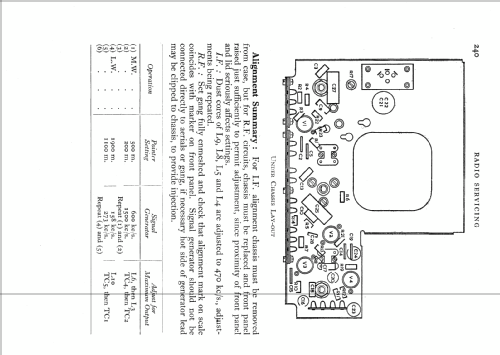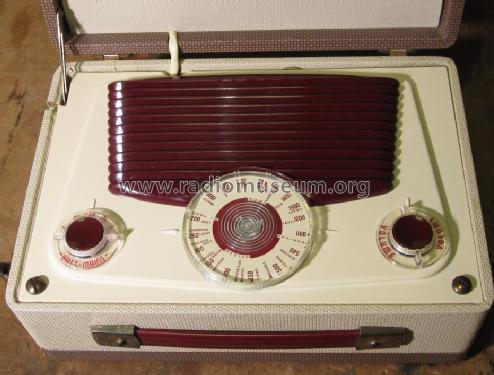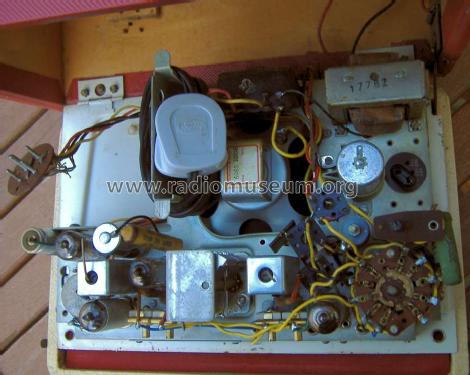My Lady Anne CN430
Vidor Ltd.; Erith (Kent)
- País
- Gran Bretaña (GB)
- Fabricante / Marca
- Vidor Ltd.; Erith (Kent)
- Año
- 1955
- Categoría
- Radio - o Sintonizador pasado WW2
- Radiomuseum.org ID
- 74815
Haga clic en la miniatura esquemática para solicitarlo como documento gratuito.
- Numero de valvulas
- 4
- Principio principal
- Superheterodino en general
- Número de circuitos sintonía
- 6 Circuíto(s) AM
- Gama de ondas
- OM y OL
- Tensión de funcionamiento
- Red / Baterías o pilas / 200-250 or 7.5 & 90 Volt
- Altavoz
- Altavoz dinámico (de imán permanente)
- Material
- Cuero/Tela/ Plástico sobre otros materiales
- de Radiomuseum.org
- Modelo: My Lady Anne CN430 - Vidor Ltd.; Erith Kent
- Forma
- Portátil > 20 cm (sin la necesidad de una red)
- Ancho, altura, profundidad
- 290 x 118 x 200 mm / 11.4 x 4.6 x 7.9 inch
- Anotaciones
-
Im Deckel eingebaute Rahmenantenne./ Frame aerial in the lid.
Earlier official Vidor L5546 battery using "W" connector is slightly different in size (3" x 3.5" x 3.5") to Vidor L5550 /Ever Ready B148 (2.75" x 3.5" x 3.5") But GEC does suggest the BB548 (=B148 & L5550). Later models do list Vidor battery L5550 in case.
Space to wind mains flex.
Lid switch "howls" to remind you rather than switching off power.
The tuning knob has a screw clamp under the chassis plate, accessible from front edge, but the other knobs are "push on" (lever from under side to avoid breakage).
Metal Rectifier and Isolated mains transformer but resistive dropper from HT for LT.
- Peso neto
- 3.5 kg / 7 lb 11.3 oz (7.709 lb)
- Precio durante el primer año
- 14.00 £
- Documentación / Esquemas (1)
- Trader Service Sheet (suppl. of Wireless & El. Trader, etc.) (Nr. 1215, 10 September 1955)
- Documentación / Esquemas (2)
- Radio And Television Servicing books (R&TVS) (Pages 238-240)
- Autor
- Modelo creado por Bernd P. Kieck. Ver en "Modificar Ficha" los participantes posteriores.
- Otros modelos
-
Donde encontrará 146 modelos, 79 con imágenes y 75 con esquemas.
Ir al listado general de Vidor Ltd.; Erith (Kent)
Colecciones
El modelo My Lady Anne es parte de las colecciones de los siguientes miembros.
Contribuciones en el Foro acerca de este modelo: Vidor Ltd.; Erith: My Lady Anne CN430
Hilos: 1 | Mensajes: 1
habe gerade ein solches Gerät repariert.
Der AÜ ein EI42 war defekt. Es läßt sich ohne Probleme ein beschaffbarer M42 einbauen.
Noch ein Tipp. Die Knöpfe lassen sich leicht entfernen, wenn ein langer Schraubenzieher unter
dem Chassis mit drückt.
Der Senderknopf ist mit einer Schelle auf der Drehkoachse festgeschraubt, die Schraube
erreicht man unterhalb des Chassis durch eine Öffnung.
Die wieder erreichte Leistung des Radios ist erstaunlich.
Gruß Klaus
Klaus Bayer, 16.Jun.06





































